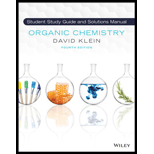
a)
Interpretation:
The products need to be predicted when tripalmitolein is treated with the given set of reagents.
Concept introduction:
Reduction is a reaction in which hydrogen is added to the given compound. One of the examples is conversion of unsaturated bonds to saturated bonds.
To predict: the product formed when tripalmitolein is treated with excess hydrogen and nickel.
a)
Answer to Problem 29PP
Solution:
The product predicted when tripalmitolein is treated with hydrogen and nickel is,
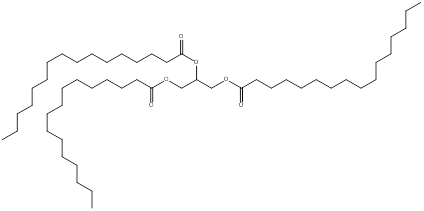
Explanation of Solution
Structure of tripalmitolein

The structure of tripalmitolein is drawn as above. In tripalmitolein there are three double bonds.
Reaction with excess hydrogen and nickel.
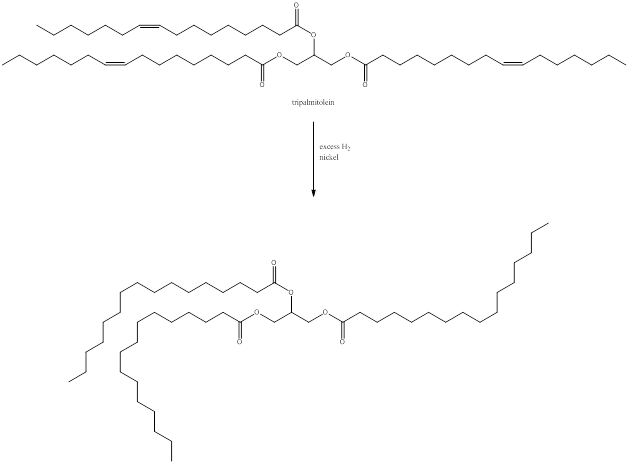
When tripalmitolein is treated with excess hydrogen and nickel, all the double bonds present in the fatty acid residue are reduced to saturated bonds to give a saturated triglyceride as shown above.
The product formed when tripalmitolein undergoes reaction with excess hydrogen and nickel is a saturated triglyceride and the structure is,
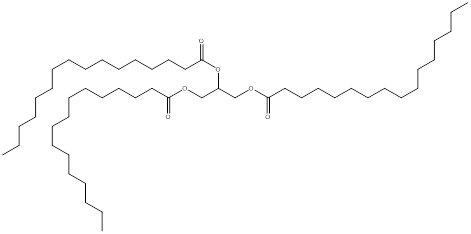
(b)
Interpretation:
The products need to be predicted when tripalmitolein is treated with the given set of reagents.
Concept introduction:
When triglyceride is treated with aqueous sodium hydroxide, the ester group is hydrolyzed to give glycerol and the fatty acid as carboxylate ion.
To predict: the product formed when tripalmitolein is treated with aqueous sodium hydroxide.
(b)
Answer to Problem 29PP
Answer
The product obtained when tripalmitolein is treated with aqueous base is,

Explanation of Solution
Structure of tripalmitolein

The structure of tripalmitolein is drawn as above. In tripalmitolein there are three ester groups.
Reaction with excess hydrogen and nickel.
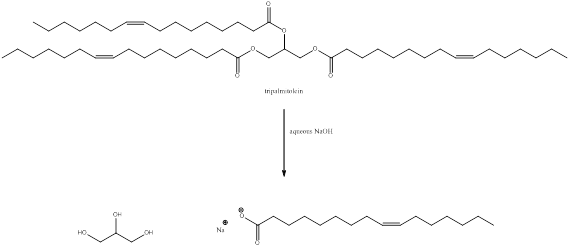
When tripalmitolein is treated with aqueous sodium hydroxide the ester group is hydrolyzed to form glycerol and fatty acid carboxylate ion.
The product formed when tripalmitolein is treated with aqueous sodium hydroxide is glycerol and three equivalents of carboxylate ion,

Want to see more full solutions like this?
Chapter 26 Solutions
ORGANIC CHEMISTRY-WILEYPLUS NEXTGEN
- 6.15PM Sun Mar 30 K Draw the major product of this reaction. Include any relevant stereochemistry. Ignore inorganic byproducts. Problem 1 of O H [PhзPCH2CH3]*C|¯ NaH Drawing > Q Atoms, Bonds and Draw or tap a nearrow_forward8:17 PM Sun Mar 30 Draw the major product of this reaction. Ignore inorganic byproducts. HSCH2CH2CH2SH, BF3 Probler Drawing Ato Bonds Clarrow_forwardpresented by Mr L How the coprion. (Il Done in no wraction, dew the starting redential) доarrow_forward
- 8:16 PM Sun Mar 30 K Draw the major product of this reaction. Ignore inorganic byproducts. Proble 1. CH3MgBr 2. H3O+ F Drawingarrow_forwardо но оarrow_forwardName the major organic product of the following action of 4-chloro-4-methyl-1-pentanol in neutral pollution 10+ Now the product. The product has a molecular formula f b. In a singly hain, the starting, material again converts into a secule with the molecular kormula CIO. but with comply Draw the major organic structure inhalationarrow_forward
- Macmillan Learning Alcohols can be oxidized by chromic acid derivatives. One such reagent is pyridinium chlorochromate, (C,H,NH*)(CICTO3), commonly known as PCC. Draw the proposed (neutral) intermediate and the organic product in the oxidation of 1-butanol by PCC when carried out in an anhydrous solvent such as CH₂C₁₂. PCC Intermediate OH CH2Cl2 Draw the intermediate. Select Draw Templates More с H Cr о Product Draw the product. Erase Select Draw Templates More H о Erasearrow_forwardIf I have 1-bromopropene, to obtain compound A, I have to add NaOH and another compound. Indicate which compound that would be. A C6H5 CH3arrow_forwardProvide the reagents for the following reactions.arrow_forward
- If I have 1-bromopropene, to obtain compound Z, I have to add two compounds A1 and A2. Indicate which compounds are needed. P(C6H5)3arrow_forwardDraw the major product of this reaction. Ignore inorganic byproducts. Assume that the water side product is continuously removed to drive the reaction toward products. O CH3CH2NH2, TSOH Select to Draw >arrow_forwardPredict the major organic product(s) for the following reaction.arrow_forward
 ChemistryChemistryISBN:9781305957404Author:Steven S. Zumdahl, Susan A. Zumdahl, Donald J. DeCostePublisher:Cengage Learning
ChemistryChemistryISBN:9781305957404Author:Steven S. Zumdahl, Susan A. Zumdahl, Donald J. DeCostePublisher:Cengage Learning ChemistryChemistryISBN:9781259911156Author:Raymond Chang Dr., Jason Overby ProfessorPublisher:McGraw-Hill Education
ChemistryChemistryISBN:9781259911156Author:Raymond Chang Dr., Jason Overby ProfessorPublisher:McGraw-Hill Education Principles of Instrumental AnalysisChemistryISBN:9781305577213Author:Douglas A. Skoog, F. James Holler, Stanley R. CrouchPublisher:Cengage Learning
Principles of Instrumental AnalysisChemistryISBN:9781305577213Author:Douglas A. Skoog, F. James Holler, Stanley R. CrouchPublisher:Cengage Learning Organic ChemistryChemistryISBN:9780078021558Author:Janice Gorzynski Smith Dr.Publisher:McGraw-Hill Education
Organic ChemistryChemistryISBN:9780078021558Author:Janice Gorzynski Smith Dr.Publisher:McGraw-Hill Education Chemistry: Principles and ReactionsChemistryISBN:9781305079373Author:William L. Masterton, Cecile N. HurleyPublisher:Cengage Learning
Chemistry: Principles and ReactionsChemistryISBN:9781305079373Author:William L. Masterton, Cecile N. HurleyPublisher:Cengage Learning Elementary Principles of Chemical Processes, Bind...ChemistryISBN:9781118431221Author:Richard M. Felder, Ronald W. Rousseau, Lisa G. BullardPublisher:WILEY
Elementary Principles of Chemical Processes, Bind...ChemistryISBN:9781118431221Author:Richard M. Felder, Ronald W. Rousseau, Lisa G. BullardPublisher:WILEY





